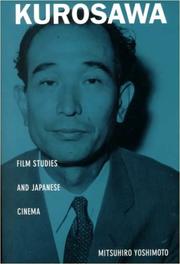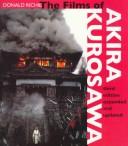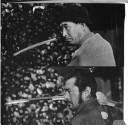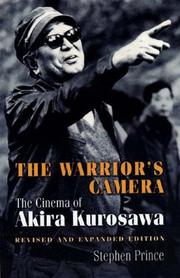| Listing 1 - 9 of 9 |
Sort by
|

ISBN: 0822324830 0822325195 Year: 2000 Publisher: Durham, N.C. Duke University Press
Abstract | Keywords | Export | Availability | Bookmark
 Loading...
Loading...Choose an application
- Reference Manager
- EndNote
- RefWorks (Direct export to RefWorks)
Kurosawa, Akira --- J6839 --- Japan: Media arts and entertainment -- cinema --- -Criticism and interpretation --- Kurosawa, Akira, --- Heize, Ming, --- Kurosava, Akira, --- Kurōcāvā, Akirā, --- 黑沢明, --- 黑澤明, --- 黒沢明, --- 黒澤明, --- Kūrūsāvā, Ākīrā, --- کوروساوا، آکيرا, --- Criticism and interpretation. --- 黑沢明 --- Akira, Kurosawa --- Heize, Ming --- Kurosava, Akira --- Kurōcāvā, Akirā --- Kūrūsāvā, Ākīrā

ISBN: 0520051378 0520051912 9780520051379 9780520051911 Year: 1984 Publisher: Berkeley University of California Press
Abstract | Keywords | Export | Availability | Bookmark
 Loading...
Loading...Choose an application
- Reference Manager
- EndNote
- RefWorks (Direct export to RefWorks)
791.471 KUROSAWA --- CDL --- Kurosawa, Akira, --- Heize, Ming, --- Kurosava, Akira, --- Kurōcāvā, Akirā, --- Kūrūsāvā, Ākīrā, --- کوروساوا، آکيرا, --- 黑沢明 --- 黑澤明, --- 黒沢明, --- 黒澤明, --- Criticism and interpretation. --- Kurosawa, Akira --- Akira, Kurosawa --- Heize, Ming --- Kurosava, Akira --- Kurōcāvā, Akirā --- Kūrūsāvā, Ākīrā
Book
ISBN: 9781138827097 9781315738741 9781317574620 9781317574637 9781138590663 1138827096 1138590665 Year: 2018 Publisher: London Routledge
Abstract | Keywords | Export | Availability | Bookmark
 Loading...
Loading...Choose an application
- Reference Manager
- EndNote
- RefWorks (Direct export to RefWorks)
Kurosawa, Akira, --- Critique et interprétation --- Criticism and interpretation. --- Influence. --- Rashōmon (Motion picture) --- Rashōmon (film) --- Heize, Ming, --- Kurosava, Akira, --- Kurōcāvā, Akirā, --- Kūrūsāvā, Ākīrā, --- کوروساوا، آکيرا, --- 黑沢明 --- 黑澤明, --- 黒沢明, --- 黒澤明, --- Rashōmon (Motion picture) --- Kurosawa, Akira --- Critique et interprétation. --- J6839 --- Japan: Media arts and entertainment -- cinema --- Akira, Kurosawa --- Heize, Ming --- Kurosava, Akira --- Kurōcāvā, Akirā --- Kūrūsāvā, Ākīrā
Book
ISBN: 9781780233437 1780233434 Year: 2014 Volume: *26 Publisher: London Reaktion Books
Abstract | Keywords | Export | Availability | Bookmark
 Loading...
Loading...Choose an application
- Reference Manager
- EndNote
- RefWorks (Direct export to RefWorks)
Film criticism --- #SBIB:309H1323 --- #SBIB:309H1320 --- Motion picture criticism --- Motion pictures --- Moving-picture criticism --- Criticism --- Films met een amusementsfunctie en/of esthetische functie: auteurs --- De filmische boodschap: algemene werken (met inbegrip van algemeen filmhistorische werken en filmhistorische werken per land) --- Evaluation --- Kurosawa, Akira, --- Heize, Ming, --- Kurosava, Akira, --- Kurōcāvā, Akirā, --- 黑沢明, --- 黑澤明, --- 黒沢明, --- 黒澤明, --- Kūrūsāvā, Ākīrā, --- کوروساوا، آکيرا, --- Criticism and interpretation. --- 黑沢明 --- Akira, Kurosawa --- Heize, Ming --- Kurosava, Akira --- Kurōcāvā, Akirā --- Kūrūsāvā, Ākīrā
Book
ISBN: 023154054X 9780231540544 0231172923 9780231172929 Year: 2016 Publisher: New York, NY
Abstract | Keywords | Export | Availability | Bookmark
 Loading...
Loading...Choose an application
- Reference Manager
- EndNote
- RefWorks (Direct export to RefWorks)
The idea that Japanese art is produced through rote copy and imitation is an eighteenth-century colonial construct, with roots in Romantic ideals of originality. Offering a much-needed corrective to this critique, Michael Lucken demonstrates the distinct character of Japanese mimesis and its dynamic impact on global culture, showing through several twentieth-century masterpieces the generative and regenerative power of Japanese arts.Choosing a representative work from each of four modern genres-painting, film, photography, and animation-Lucken portrays the range of strategies that Japanese artists use to re-present contemporary influences. He examines Kishida Ryusei's portraits of Reiko (1914-1929), Kurosawa Akira's Ikiru (1952), Araki Nobuyoshi's photographic novel Sentimental Journey-Winter (1991), and Miyazaki Hayao's popular anime film Spirited Away (2001), revealing the sophisticated patterns of mimesis that are unique but not exclusive to modern Japanese art. In doing so, Lucken identifies the tensions that drive the Japanese imagination, which are much richer than a simple opposition between progress and tradition, and their reflection of human culture's universal encounter with change. This global perspective explains why, despite its non-Western origins, Japanese art has earned such a vast following.
Creation (Literary, artistic, etc.) --- Imitation in art. --- Art --- Pictures --- Appropriation (Art) --- Mimesis in art --- Creative ability in art --- Creative ability in literature --- Imagination --- Inspiration --- Literature --- Creative ability --- Originality --- Reproduction --- Copying --- Kishida, Ryūsei, --- Kurosawa, Akira, --- Araki, Nobuyoshi, --- Miyazaki, Hayao, --- 宮崎駿, --- 荒木経惟, --- 荒木經惟, --- 荒木経帷, --- Heize, Ming, --- Kurosava, Akira, --- Kurōcāvā, Akirā, --- Kūrūsāvā, Ākīrā, --- کوروساوا، آکيرا, --- 黑沢明 --- 黑澤明, --- 黒沢明, --- 黒澤明, --- Ryūsei, Kishida, --- 岸田劉生, --- Criticism and interpretation. --- 宮崎, 駿 --- Akira, Kurosawa --- Heize, Ming --- Kurosava, Akira --- Kurōcāvā, Akirā --- Kūrūsāvā, Ākīrā

ISBN: 0520017811 9780520017818 Year: 1973 Publisher: Berkeley : University of California Press,
Abstract | Keywords | Export | Availability | Bookmark
 Loading...
Loading...Choose an application
- Reference Manager
- EndNote
- RefWorks (Direct export to RefWorks)
Motion pictures --- film --- filmregisseurs --- twintigste eeuw --- Kurosawa, Akira --- Japan --- 791.471 KUROSAWA --- KFL --- Kurosawa, Akira, --- Akira, Kurosawa --- Heize, Ming --- Kurosava, Akira --- Kurōcāvā, Akirā --- Kūrūsāvā, Ākīrā --- کوروساوا، آکيرا, --- 黑沢明 --- 黑澤明, --- 黒沢明, --- 黒澤明, --- KUROSAWA, AKIRA (1910-...) --- FILMOGRAPHIE
Book
ISBN: 1844576647 9781844576647 Year: 2014 Publisher: London Palgrave Macmillan, on behalf of the British Fillm Institute
Abstract | Keywords | Export | Availability | Bookmark
 Loading...
Loading...Choose an application
- Reference Manager
- EndNote
- RefWorks (Direct export to RefWorks)
Sequential interpretation of Kurosowa's 1957 reworking of Macbeth explores how the director drew key philosophical and psychological arguments from Shakespeare, translated them into strong visual metaphors, and inflected them through the history of post-World War II Japan.
Shakespeare, William, --- Kurosawa, Akira, --- Film adaptations. --- Throne of blood (Motion picture) --- Sciarrino, Salvatore. --- Heize, Ming, --- Kurosava, Akira, --- Kurōcāvā, Akirā, --- 黑沢明, --- 黑澤明, --- 黒沢明, --- 黒澤明, --- Kūrūsāvā, Ākīrā, --- کوروساوا، آکيرا, --- #SBIB:309H1320 --- #SBIB:309H1321 --- De filmische boodschap: algemene werken (met inbegrip van algemeen filmhistorische werken en filmhistorische werken per land) --- Films met een amusementsfunctie en/of esthetische functie: algemeen --- Criticism and interpretation. --- Throne of blood (Motion picture : 1957). --- J6839 --- Japan: Media arts and entertainment -- cinema --- 黑沢明 --- Throne of blood (Motion picture : 1957) --- Kumonosu-jō (Motion picture) --- 蜘蛛巣城 (Motion picture) --- Kumosu-jō (Motion picture) --- Kurosawa, Akira --- Akira, Kurosawa --- Heize, Ming --- Kurosava, Akira --- Kurōcāvā, Akirā --- Kūrūsāvā, Ākīrā --- Shakespeare, William
Book
ISBN: 2856010296 9782856010297 Year: 1983 Publisher: [Paris] Edilig
Abstract | Keywords | Export | Availability | Bookmark
 Loading...
Loading...Choose an application
- Reference Manager
- EndNote
- RefWorks (Direct export to RefWorks)
Motion picture producers and directors --- filmregisseurs --- film --- twintigste eeuw --- Japan --- Kurosawa, Akira --- 791.471 KUROSAWA --- KFL --- Directors, Motion picture --- Film directors --- Film producers --- Filmmakers --- Motion picture directors --- Moviemakers --- Moving-picture producers and directors --- Producers, Motion picture --- Persons --- Kurosawa, Akira, --- Akira, Kurosawa --- Heize, Ming --- Kurosava, Akira --- Kurōcāvā, Akirā --- Kūrūsāvā, Ākīrā --- کوروساوا، آکيرا, --- 黑沢明 --- 黑澤明, --- 黒沢明, --- 黒澤明, --- CINEMA --- KUROSAWA, AKIRA (1910-...) --- JAPON

ISBN: 0691031606 0691008590 0691214182 Year: 1991 Publisher: Princeton Princeton university press
Abstract | Keywords | Export | Availability | Bookmark
 Loading...
Loading...Choose an application
- Reference Manager
- EndNote
- RefWorks (Direct export to RefWorks)
The Japanese film director Akira Kurosawa, who died at the age of 88, has been internationally acclaimed as a giant of world cinema. Rashomon, which won both the Venice Film Festival's grand prize and an Academy Award for best foreign-language film, helped ignite Western interest in the Japanese cinema. Seven Samurai and Yojimbo remain enormously popular both in Japan and abroad. In this newly revised and expanded edition of his study of Kurosawa's films, Stephen Prince provides two new chapters that examine Kurosawa's remaining films, placing him in the context of cinema history. Prince also discusses how Kurosawa furnished a template for some well-known Hollywood directors, including Martin Scorsese, Steven Spielberg, and George Lucas. Providing a new and comprehensive look at this master filmmaker, The Warrior's Camera probes the complex visual structure of Kurosawa's work. The book shows how Kurosawa attempted to symbolize on film a course of national development for post-war Japan, and it traces the ways that he tied his social visions to a dynamic system of visual and narrative forms. The author analyzes Kurosawa's entire career and places the films in context by drawing on the director's autobiography--a fascinating work that presents Kurosawa as a Kurosawa character and the story of his life as the kind of spiritual odyssey witnessed so often in his films. After examining the development of Kurosawa's visual style in his early work, The Warrior's Camera explains how he used this style in subsequent films to forge a politically committed model of filmmaking. It then demonstrates how the collapse of Kurosawa's efforts to participate as a filmmaker in the tasks of social reconstruction led to the very different cinematic style evident in his most recent films, works of pessimism that view the world as resistant to change.
791.44
---
J6839
---
J6800.80
---
Filmproductie. Filmindustrie
---
Japan: Media arts and entertainment -- cinema
---
Japan: Performing and media arts -- history -- Gendai (1926- ), Shōwa period, 20th century
---
Kurosawa, Akira
---
-Criticism and interpretation
---
791.44 Filmproductie. Filmindustrie
---
Kurosawa, Akira,
---
Heize, Ming,
---
Kurosava, Akira,
---
Kurōcāvā, Akirā,
---
黑沢明,
---
黑澤明,
---
黒沢明,
---
黒澤明,
---
Kūrūsāvā, Ākīrā,
---
کوروساوا، آکيرا,
---
Criticism and interpretation.
---
黑沢明
---
Film.
---
Cine
---
Producción y dirección
---
Kurosawa, Akira.
---
Crítica e interpretación.
---
Bibel
---
Japan.
---
American Western.
---
Ashikaga era.
---
Bakhtin, Mikhail.
---
Buddhism.
---
Chaplin, Charles.
---
Dersu Uzala.
---
Dodeskaden.
---
Drunken Angel.
---
Eisenstein, Sergei.
---
Godard, Jean-Luc.
---
Gorky, Maxim.
---
Hayasaka Fumio.
---
Hojoki.
---
Ikiru.
---
Kagemusha.
---
Leone, Sergio.
---
Madadayo.
---
Marxism.
---
Nakadai Tatsuya.
---
Neo-Confucianism.
---
Noh theater.
---
Oda Nobunaga.
---
Oguni Hideo.
---
Peckinpah, Sam.
---
Ran.
---
Red Beard.
---
Sengoku period.
---
Shimura Takashi.
---
Takeda Shingen.
---
Tokugawa period.
---
haiku.
---
individualism.
---
karma.
---
satori.
---
Philemonbrief
---
<
| Listing 1 - 9 of 9 |
Sort by
|

 Search
Search Feedback
Feedback About UniCat
About UniCat  Help
Help News
News